I had just learned about the ancient bristlecone pine trees—the world’s oldest known trees—at Great Basin National Park, and my fascination with them plus further research led me to the discovery of the Ancient Bristlecone Pine Forest. During my side trip of summiting Mount Whitney, I learned that the Ancient Bristlecone Pine Forest was not far. In fact, it was right off our route north on Highway 395, nestled in the White Mountains in Inyo National Forest. We headed there the day after we summited Mount Whitney.
Within this ancient forest is the 4.5-mile loop trail that includes the bristlecone pine named Methuselah, known for many years as the world’s oldest tree and living organism at 4,750+ years old. However, in order to protect Methuselah from vandalism, this tree is not labeled. Curious, I google imaged “Methuselah bristlecone pine” before the hike and saw dozens of pictures of this tree. I snapped a screenshot and set off on the trail determined to find it.
Well, we studied the photos, searched and searched for this tree in the Methuselah Grove, and finished the 4.5-mile hike slightly disheartened that we could not find the damn tree! With dismay we admitted to a park ranger that we could not find Methuselah, and she told us that the tree was not as obvious as one would think.
“But the photos from the internet make it appear so distinct, so easy to find,” I said.
“There aren’t any photos of Methuselah on the internet,” she laughed.
“What?!” Had Chris and I been wastefully searching for this damn tree? “I thought it was all over the internet.”
“Nope, those pictures you see on the internet are not of Methuselah. It’s the wrong tree.”
I showed her my collection of images.
“Nope, none of those are of Methuselah,” she confirmed.
Well then!
But then she proceeded to give us a hint, for next time. “I believe the 1958 March issue of National Geographic has a picture of part of Methuselah.” Chris and I haven’t searched for this issue just yet, but next time we return to the Ancient Bristlecone Pine Forest, we’ll make sure to look it up!
Despite not being able to ogle over the mighty Methuselah, we still enjoyed every bit of the hike. Situated high in the mountains at 10,000 feet, we were able to see the surrounding California landscape sprawling below us.
The Sierra Nevada mountains to the west:
And even Death Valley to the east:
The ancient bristlecone pines must be seen to be believed. They are sculptures in a desert, or a piece of imagination, or an illustration of a child’s horror story, with their tangled roots and outstretched branches seemingly defying nature. They are unreal…but they are real.
Its longevity depends on location—the harsher the environment, the longer the lifespan. Its incredibly slow growth (about 1 inch per century) results in a very dense wood, making it sturdy enough to withstand environments its neighboring trees can’t endure. Unlike most trees, the bristlecone pine survives on nutrient-poor, rock-like “soil,” allowing them to live without competition. Parts of the root, branch, or trunk also “die back” when it is harmed by drought or diseases in order to protect the rest of the tree and keep it growing. In addition to living thousands of years, the bristlecone pine also remains on earth for thousands of years after death!
“We do know that the oldest trees survive in the most difficult situations. Perhaps there is a life lesson there for all of us.” ~from the Methuselah Walk brochure

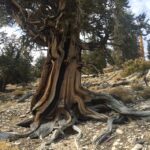
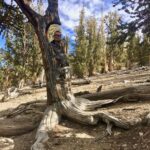
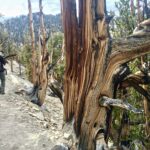
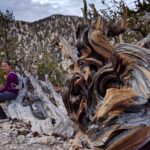
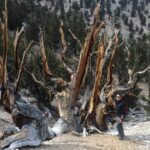
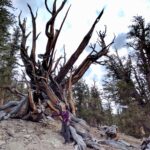
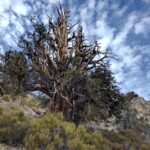
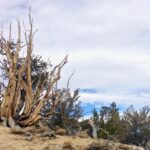
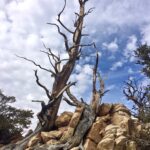
Pingback: Mammoth Lakes | Romping & Nguyening